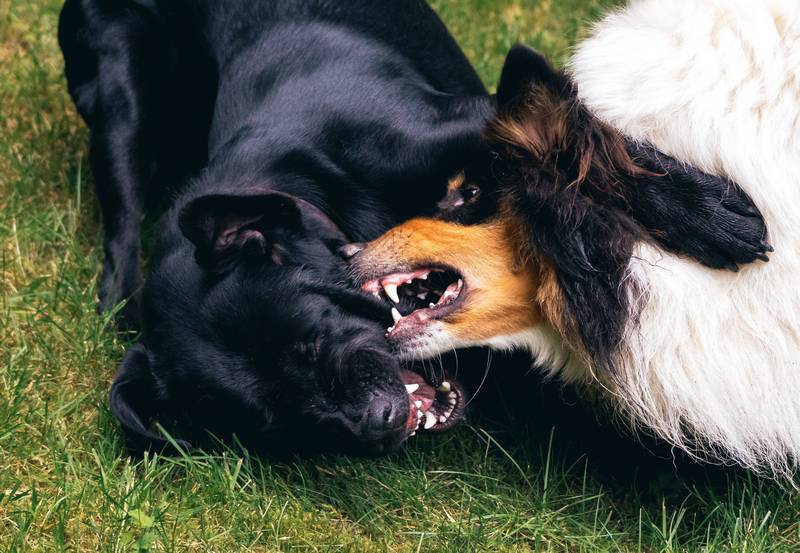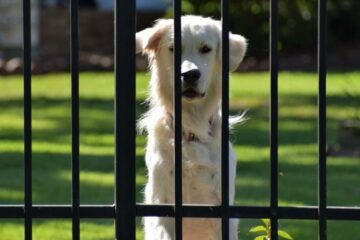Dog Biting Other Dogs’ Necks? How to Stop It RIGHT AWAY!
Picture this: You’re at the dog park, and your furry friend is having a blast – but then, suddenly, you notice your dog biting another dog’s neck. Yikes! If this scenario sounds familiar, or you’re worried about it happening, you’ve come to the right place. In this article, we’ll dive into the possible reasons for this behavior and give you some tips on how to put a stop to it ASAP.
From understanding the difference between play and aggression, to learning about dog neck biting dominance, we’ll cover everything you need to know. We’ll also discuss why dogs sometimes bite necks when playing and whether or not it’s normal and safe. Soon, you’ll know what’s going on with your pup and how to keep everyone happy and safe.
Ready to tackle this issue head-on? Let’s get started below with our article “Dog Biting Other Dogs’ Necks? How to Stop It Right Away!”
How to Stop Dog Biting Other Dogs’ Necks

To stop dog biting other dogs’ necks, immediately try to divert their attention by loudly clapping or giving a “stop” command. If this doesn’t work, attempt to separate the dogs using something like a long broom handle. Do not put your hands near either dogs’ mouth or you may get bitten.
If there is nothing around you can quickly grab to pry the dogs apart, then you should use the wheelbarrow method. Grab your dog by the hind legs and pull them away, then keep the dogs separated even after they’ve both calmed down. Calmly but firmly tell your dog no and end playtime by placing them into time-out or taking them home.
These steps will get your dog to stop biting other dogs’ necks, but it’s important to remember that the underlying behavioral issues (dominance, anxiety) that were causing all of this to begin with will still be present. And until you address that, any positive changes you see are only going to be temporary.
“So, how do I make these changes stick, then?”
By getting your dog to truly choose to follow your direction, that’s how. I tried many times to write out how you can do that before deciding it made more sense to just link you to the free video series that explains it better than I’d ever be able to.
The series is by a man named Dan who is one of the world’s leading dog obedience trainers. In it, he teaches you how to put an end to things like when your dog bites other dogs’ necks and all other misbehavior using his fast and easy-to-follow methods.
In the first video, Dan will reveal to you why the two most common methods of dog training only doom you to failure. You can watch the video now by clicking here. Follow the proven system he’ll show you in his series and you’ll never have to spend another second worrying about your dog biting other dogs’ necks ever again!
What Does It Mean When a Dog Bites Another Dog’s Neck?

When a dog bites another dog’s neck, it can be a sign of dominance, playfulness, or aggression. In some cases, this behavior is completely normal and harmless, especially when dogs are playing together. However, it can also indicate a deeper issue that needs addressing, such as underlying aggression or anxiety.
First, let’s talk about play. Dogs often play by biting and mouthing each other’s necks, as it mimics the natural hunting behavior of their wild ancestors. It’s not uncommon to see dogs engaging in this kind of roughhousing, and it usually doesn’t cause any harm.
Keep an eye on the dogs’ body language and energy levels, as this can give you clues about whether the interaction is friendly or not. Happy, playful dogs will often have relaxed body language, wagging tails, and an overall bouncy energy.
On the other hand, if you notice that your dog is biting another dog’s neck with a tense posture, growling, or baring its teeth, this might be a sign of aggression. Aggression in dogs can stem from various causes, such as fear, resource guarding, or territorial behavior. It’s important to identify the underlying cause of the aggression to effectively address the issue and prevent any harm to the dogs involved.
Dominance is another reason a dog might bite another dog’s neck. In this case, the dog is trying to establish its position in the social hierarchy. If your dog is consistently biting other dogs’ necks to assert control, it’s crucial to find a way to manage this behavior to keep all dogs safe and comfortable.
Lastly, anxiety or fear might cause a dog to bite another dog’s neck. An anxious or fearful dog might perceive another dog as a threat, even if that dog is simply being friendly. In these situations, the biting is a defensive behavior aimed at making the perceived threat go away.
For obvious reasons, you should always stay on the side of caution if you’re unsure about what’s going on. If you think your dog is biting other dogs’ necks due to aggression, your first course of action should be to separate the pair immediately by distracting them but not physically getting involved. If you get too close, they might bite you and draw blood.
If the dogs don’t immediately respond to commands to stop and there’s nothing on hand you can quickly grab like a broom handle to pry the dogs apart, use what is called the wheelbarrow method. Think of how one pushes around a wheelbarrow, and grab your dog by their hind legs while pulling them away. Remember to not attempt to place your hands near either dog’s mouth.
Once you have the dogs safely apart, keep them that way for the time being even if they normally get along fine. You then need to begin behavioral training immediately. Your dog should never be attacking another dog or refusing your commands to stop, even if they’re only playing.
Brushing your dog biting other dogs’ necks off as a one-time thing, or just “dogs being dogs” will give them the idea that this sort of thing is acceptable. Soon, even at calmer times, your dog will be trying to bite other dogs’ ears, bite other dogs’ tails, or bite other dogs’ legs. You can probably see why you need to handle this before it becomes an even worse problem.
To learn how to address your dog’s issues at the root (so you can end the misbehavior for good, not just transfer it somewhere else), go back to the first section of this article now.
Dog Grabbing Other Dog’s Neck and Shaking
A dog grabbing another dog’s neck and shaking can be an alarming sight, and it may indicate different things depending on the situation, such as play or aggression.
In some cases, the neck grabbing and shaking behavior is part of playtime. Dogs often play rough, and their games can resemble their natural predatory behaviors. During play, one dog may grab the other’s neck and shake it as if they were catching prey.
While this might look concerning, it can be a normal part of play as long as both dogs are comfortable with the interaction. Pay attention to their body language, such as wagging tails, relaxed postures, and play bows, to ensure the encounter remains friendly.
However, if a dog grabs another dog’s neck and shakes it in a tense or aggressive manner, it could signal a problem. This behavior might be a display of aggression, possibly due to fear, resource guarding, or territorial instincts.
Growling, snarling, and stiff body postures can be indicators of aggression. If you observe these signs, it’s crucial to intervene and separate the dogs to prevent potential injuries.
Sometimes, the neck grabbing and shaking behavior might be an attempt to assert dominance. If your dog is grabbing and shaking another dog’s neck to assert control, it’s vital to address this behavior immediately through training and management techniques to maintain a peaceful environment for all dogs involved. Go back to the first section to learn how.
In any case, when you observe your dog grabbing another dog’s neck and shaking, it’s important to assess the situation and intervene if necessary. Ensuring the safety and well-being of both dogs should be the top priority.
Why Does My Dog Bite My Other Dog’s Neck?
Your dog might bite your other dog’s neck for several reasons, including play, establishing dominance, or as a reaction to fear or anxiety. Understanding the context of the behavior and observing your dogs’ body language will help you determine the cause of the neck biting.
In a multi-dog household, dogs often engage in play that involves mouthing or biting each other’s necks. This is a natural form of play and a way for dogs to strengthen their bond. However, it’s important to supervise playtime and ensure that both dogs are comfortable with the interaction.
Look for signs of relaxed body language, like wagging tails and play bows, which indicate a friendly and playful encounter.
If the neck biting appears more assertive or forceful, it might be an attempt to establish dominance within the household hierarchy. If you suspect that your dog is biting your other dog’s neck to assert dominance, you need to address this behavior through proper training and management techniques to ensure a peaceful home environment.
Fear or anxiety can also lead to neck biting. If one of your dogs is fearful or anxious, they might perceive the other dog as a threat, causing them to bite the other dog’s neck in a defensive manner.
In this case, it’s crucial to recognize the signs of fear or anxiety in your dog and work on alleviating those emotions through positive reinforcement training, desensitization, and counter-conditioning methods. Go back to the first section of this article and we’ll explain how.
Why Do Dogs Bite Necks When Playing?
Dogs bite necks when playing as a way to engage in mock battles and practice natural predatory behaviors. This type of play stems from their wild ancestors, who used these behaviors for hunting and survival. Neck biting during play allows dogs to develop social and physical skills while enjoying an energetic and interactive game with their playmates.
It’s important to remember that neck biting in play is usually non-threatening and non-aggressive. Dogs engaged in friendly play will often display relaxed body language, such as wagging tails, play bows, and open mouths with relaxed facial expressions.
Additionally, you might notice that the dogs take turns being the “aggressor” and the “defender” during play, which is a sign that the interaction is balanced and consensual.
Dominance can also play a role in dog play dynamics. Some dogs may bite another dog’s neck to assert a higher position in their social hierarchy. In these instances, the neck biting is generally harmless and both dogs are comfortable with the interaction. However, it’s important to monitor the situation closely to ensure that the play does not escalate into aggression.
To keep playtime safe and enjoyable for all dogs involved, you need to supervise their interactions and intervene if necessary. If you notice that the play is becoming too rough or one dog seems uncomfortable, it’s a good idea to step in and calmly separate the dogs. You can learn how to safely separate biting dogs in the first section of this article.
Dog Neck Biting During Play: Is It Normal and Safe?
Dog neck biting during play is generally normal and safe, as long as both dogs are comfortable and displaying friendly body language. This type of behavior is a natural part of canine play and allows dogs to practice their social and physical skills while bonding with their playmates.
When dogs are engaged in mutual play, you’ll see them showing positive signs like relaxed body language, wagging tails, play bows, and open mouths with calm expressions on their faces. You might also notice that the dogs take turns being the one that’s aggressive and the one that’s defending, which is a sign that the interaction is balanced and consensual.
As long as both dogs appear happy and relaxed, neck biting during play is typically harmless and safe.
However, it’s important to closely monitor your dog’s playtime to ensure that it remains safe and enjoyable. Look for any signs of discomfort or distress from either dog, such as excessive vocalization, tucked tails, or attempts to escape the interaction.
If you observe any of these signs, it’s a good idea to intervene and calmly separate the dogs to prevent any potential injuries or negative experiences.
Additionally, be aware of your dog’s size, breed, and play style when matching them with playmates. Some dogs have a naturally rougher play style that might not be suitable for smaller or more timid dogs. Always make sure to pair your dog with a playmate of a similar size and energy level to minimize the risk of injury during playtime.
If you need to learn how to separate dogs biting each other’s necks, go back to the first section and we’ll teach you how to do so safely.
Dog Neck Biting Dominance: What Is It Rooted In?
Dog neck biting dominance is rooted in a dog’s instinctual drive to establish a social hierarchy within a group. This behavior is influenced by various factors, including genetics, early life experiences, and the environment. You need to understand the root causes of dominant behavior to address and manage it effectively.
Genetics plays a significant role in a dog’s temperament and predisposition to dominant behavior. Some breeds have been selectively bred for specific tasks or roles that required assertive and confident traits, making them more likely to display dominant behaviors like neck biting.
However, it’s important to remember that not all dogs within a breed will exhibit these behaviors, and individual dogs may vary greatly in temperament.
Early life experiences can also shape a dog’s propensity for dominance. Puppies that have been well-socialized and exposed to a variety of experiences are less likely to develop dominant behaviors, as they have learned to adapt to different situations and interact appropriately with other dogs.
On the other hand, a dog that has experienced a lack of socialization or has had negative experiences with other dogs may be more likely to exhibit dominant behavior, as it may perceive other dogs as threats to its social status.
The environment in which a dog is raised and the way it is managed can also contribute to dominant behavior. Inconsistent or harsh training methods, lack of structure, or permissive environments may inadvertently encourage dominant behaviors in dogs.
You need to provide a stable and predictable environment for your dog, along with consistent training and clear boundaries, to prevent the development of dominance-related issues.
If your dog exhibits neck biting dominance, it’s important to address the behavior through appropriate training and management techniques. Establishing clear boundaries, reinforcing positive behaviors, and providing mental and physical stimulation can help promote a balanced and well-adjusted dog. Go back to the first section to learn how.
Dogs Biting Necks: Recognizing Signs of Play and Aggression
Recognizing the difference between play and aggression when dogs bite necks is essential to ensure the safety of all dogs involved. Here are some key signs to look for:
Signs of Playful Neck Biting in Dogs:
- Relaxed body posture
- Wagging tails
- Play bows (lowering the front part of the body while keeping the rear end raised)
- Taking turns (both dogs engaging in neck biting and allowing themselves to be bitten)
- Open, relaxed mouths (resembling a “smile”)
Signs of Aggressive Neck Biting in Dogs:
- Stiff body posture
- Growling or snarling
- Bared teeth
- Pinned-back ears
- One dog consistently targeting the other without allowing for reciprocation
By carefully observing the dogs’ behavior and body language, you can determine whether the neck biting is playful or aggressive, allowing you to intervene when necessary to ensure the safety and well-being of all dogs involved. If you need to learn how to safely separate dogs, go back to the first section of this article and we’ll explain how.
I’m sure you’re ready to not have to stress out every time your dog’s around another dog, so I’ll let you get started now. Good luck with everything, and thank you for reading “Dog Biting Other Dogs’ Necks? How to Stop It Right Away!”





